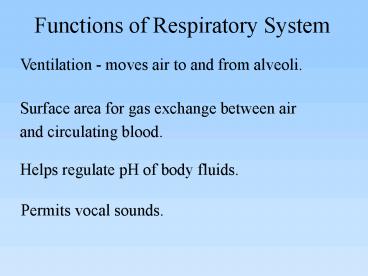Ventilation moves air to and from alveoli' - PowerPoint PPT Presentation
1 / 33
Title:
Ventilation moves air to and from alveoli'
Description:
Alveolus. Alveoli consist of 3 types of cells. 1) Alveolar Type I cells thin (epithelium) that makes the walls' of alveoli for gas exchange. ... – PowerPoint PPT presentation
Number of Views:106
Avg rating:3.0/5.0
Title: Ventilation moves air to and from alveoli'
1
Functions of Respiratory System
Ventilation - moves air to and from alveoli.
Surface area for gas exchange between air and
circulating blood.
Helps regulate pH of body fluids.
Permits vocal sounds.
2
External nares
3
Upper Respiratory System
Nose Nasal cavity Pharynx (throat) Larynx
Conditions inspired air
Filter Warm Humidify
Lower Respiratory System
Trachea Bronchi Bronchioles Alveoli gas
exchange!
Functions to conduct air to site of gas exchange.
4
Respiratory Epithelium
5
Air Moves Down its Pressure Gradient
- Inspiration Air moves from outside into lungs
as pressure in the thoracic cavity decreases
(thus, volume increases).
- Expiration Air moves from lungs to outside as
pressure in the thoracic cavity increases (thus,
volume decreases).
6
(No Transcript)
7
Muscles of Ventilation
- Eupnea Quiet breathing at rest.
Inspiration Diaphragm and External
intercostals.
increases volume
elastic recoil
Expiration No Muscle Contraction!
Metabolic cost of breathing is normally 3 BMR
8
Muscles of Ventilation
- Forceful Breathing e.g., during exercise.
Inspiration Diaphragm, External intercostals,
(Sternocleidomastoid).
Expiration Internal intercostals and
Abdominal muscles.
9
3 Important Pressures
1. Atmopheric Pressure
2. Alveolar Pressure
3. Intrapleural Pressure
10
Alveolus
11
Alveoli consist of 3 types of cells
1) Alveolar Type I cells thin (epithelium) that
makes the walls of alveoli for gas exchange.
2) Alveolar Type II cells release surfactant
which make lungs more Compliant.
3) Alveolar Macrophages protects the alveolar
surface. Release trypsin.
12
Alveoli also have elastic fibers Elastic recoil -
pushes air out (assists ventilation).
Capillaries cover 90 of alveolar surface.
13
(No Transcript)
14
Pulmonary Elasticity and Compliance
15
Pulmonary Elasticity and Compliance
16
(No Transcript)
17
Partial Pressure Gradients
Partial Pressure - pressure of a single gas in a
mixture of gases.
- Air is mixture of Gases
- N2
- O2
- CO2
79
21
0.03
- Q What is the PO2 if PATM is 760 mmHg? PCO2?
- Q Calculate the PO2 if PATM is 380 mmHg?
18
Factors influencing how a gas dissolves in liquid
- Partial Pressure gradient
- Temperature
- Solubility
19
An individual gas in a mixture moves down
its Partial Pressure Gradient
- O2 Movement
- Air to blood
- Blood to cells
- CO2 Movement
- Cells to blood
- Blood to air
20
(No Transcript)
21
How is O2 Transported ?
2 is dissolved in plasma.
98 in carried on Heme portion of hemoglobin
(Hb).
22
How is CO2 Transported ?
10 dissolved in plasma.
30 bound to globin portion of Hb.
60 as HCO3-, (bicarbonate buffer)
23
O2-Hb Saturation Curve
24
Factors that Shift the Hb-O2 Saturation Curve
pH of surroundings
Temperature
PCO2
2,3-DPG
25
(No Transcript)
26
Air Flow ?P/R
?P is?
R is?
Airway Resistance
Diameter
Bronchodilation
Bronchoconstriction
Blockage (e.g., mucous)
27
For best gas exchange need
- Wet surface
- Thin epithelia
- Large surface area
- Little ECF
Some Diseases
Emphysema
Fibrotic Lung
Pulmonary edema
Asthma
Bronchitis
28
(No Transcript)
29
(No Transcript)
30
(No Transcript)
31
Volumes
Capacities
Vital capacity Inspiratory capacity Functional
residual capacity
Tidal volume Inspiratory reserve
volume Expiratory reserve volume Residual volume
32
(No Transcript)
33
(No Transcript)































